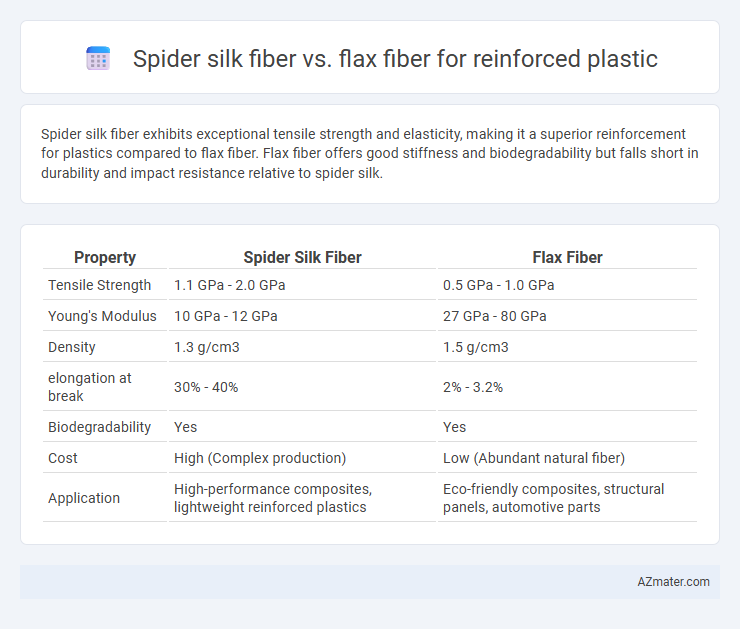Spider silk fiber exhibits exceptional tensile strength and elasticity, making it a superior reinforcement for plastics compared to flax fiber. Flax fiber offers good stiffness and biodegradability but falls short in durability and impact resistance relative to spider silk.
Table of Comparison
| Property | Spider Silk Fiber | Flax Fiber |
|---|---|---|
| Tensile Strength | 1.1 GPa - 2.0 GPa | 0.5 GPa - 1.0 GPa |
| Young's Modulus | 10 GPa - 12 GPa | 27 GPa - 80 GPa |
| Density | 1.3 g/cm3 | 1.5 g/cm3 |
| elongation at break | 30% - 40% | 2% - 3.2% |
| Biodegradability | Yes | Yes |
| Cost | High (Complex production) | Low (Abundant natural fiber) |
| Application | High-performance composites, lightweight reinforced plastics | Eco-friendly composites, structural panels, automotive parts |
Introduction to Natural Fiber Reinforced Plastics
Natural fiber reinforced plastics utilize fibers like spider silk and flax to enhance mechanical properties while reducing environmental impact. Spider silk fiber exhibits exceptional tensile strength and elasticity, making it ideal for high-performance composites, whereas flax fiber offers cost-effective, biodegradable reinforcement with good stiffness and durability. Comparing both, spider silk provides superior strength-to-weight ratio, while flax balances affordability and sustainability in reinforced plastic applications.
Overview of Spider Silk Fiber Properties
Spider silk fiber exhibits exceptional tensile strength up to 1.3 GPa and remarkable elasticity reaching elongation at break of 30%, outperforming many natural fibers like flax. Its hierarchical protein structure provides superior toughness and lightweight characteristics, making it an ideal candidate for reinforced plastics requiring high performance and durability. Furthermore, spider silk's biodegradability and natural origin contribute to sustainable composite material development, especially when compared to flax fibers known for moderate strength around 0.6 GPa and lower extensibility.
Key Characteristics of Flax Fiber
Flax fiber exhibits high tensile strength, excellent stiffness, and low density, making it a competitive natural reinforcement in plastics compared to spider silk fiber. Its biodegradability, thermal stability up to 200degC, and good moisture absorption help enhance composite durability and environmental sustainability. Flax fiber's cost-effectiveness and availability further support its application in reinforced plastic manufacturing, contrasting with the limited production and higher cost of spider silk fiber.
Mechanical Strength Comparison: Spider Silk vs Flax
Spider silk fiber demonstrates superior tensile strength and toughness compared to flax fiber, with a tensile strength ranging between 1.0 to 2.0 GPa versus flax's typical 0.5 to 1.0 GPa. The high elasticity and energy absorption capacity of spider silk provide enhanced durability and impact resistance when used in reinforced plastics. Flax fibers offer good stiffness and biodegradability but fall short of matching spider silk's combination of strength and flexibility for advanced composite applications.
Flexibility and Toughness Analysis
Spider silk fiber exhibits exceptional flexibility and superior toughness compared to flax fiber when used as reinforcement in plastics, due to its unique protein-based molecular structure that allows high elongation and energy absorption. Flax fiber, while providing good tensile strength and eco-friendly characteristics, tends to be more brittle and less capable of withstanding repeated flexural stresses without failure. The elastic modulus of spider silk ranges from 1 to 10 GPa with strain at break up to 30%, significantly outperforming flax fiber's typical modulus of 50-70 GPa but much lower strain at break, highlighting spider silk's potential for impact-resistant and flexible composite applications.
Environmental Impact and Sustainability
Spider silk fiber exhibits superior biodegradability and lower environmental footprint compared to flax fiber in reinforced plastics, due to its natural protein composition and minimal agricultural requirements. Flax fiber, while renewable and carbon-negative, demands significant land, water, and pesticide inputs, impacting ecosystems and soil health. Sustainable production of spider silk fibers offers scalable, eco-friendly alternatives with reduced greenhouse gas emissions and waste generation in composite manufacturing.
Compatibility with Polymer Matrices
Spider silk fiber exhibits excellent compatibility with various polymer matrices due to its molecular structure, enabling strong interfacial bonding and improved load transfer in reinforced plastics. Flax fiber, while natural and biodegradable, often requires surface treatment or coupling agents to enhance adhesion with hydrophobic polymers, as its cellulose-rich composition can hinder direct compatibility. Advances in fiber modification techniques have improved flax's matrix compatibility, but spider silk's inherent protein-based composition offers superior integration without extensive processing.
Cost and Scalability of Fiber Production
Spider silk fiber exhibits superior mechanical properties but faces significant challenges in cost and scalability due to limited natural production and complex synthetic replication processes. Flax fiber offers a cost-effective and scalable alternative with widespread agricultural availability and established extraction methods, making it more feasible for large-scale reinforced plastic manufacturing. The high price and production bottlenecks of spider silk restrict its industrial adoption despite its performance advantages.
Application Potential in Composite Materials
Spider silk fiber exhibits exceptional tensile strength, elasticity, and toughness, making it a highly promising reinforcement material in composite plastics, especially for high-performance applications like aerospace and biomedical devices. Flax fiber offers advantages in biodegradability, cost-effectiveness, and lower density, suitable for automotive and construction composites where environmental sustainability is prioritized. Both fibers enable lightweight, high-strength composites, but spider silk's superior mechanical properties drive innovation in cutting-edge, multifunctional materials.
Future Trends and Research Directions
Spider silk fiber exhibits exceptional tensile strength, elasticity, and biodegradability, positioning it as a promising alternative to traditional flax fibers for reinforced plastics; ongoing research aims to optimize scalable biofabrication methods and enhance compatibility with polymer matrices. Advances in genetic engineering and recombinant protein synthesis are enabling the production of synthetic spider silk at industrial scales, addressing current limitations of natural fiber supply and consistency. Future trends emphasize hybrid composites integrating spider silk and plant-based fibers like flax to achieve superior mechanical properties and environmental sustainability.

Infographic: Spider silk fiber vs Flax fiber for Reinforced plastic
 azmater.com
azmater.com